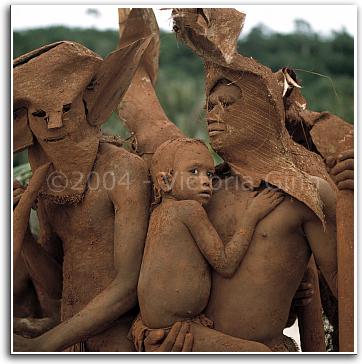|
Introduction
I began this photographic study in 1984,
following the seasons and my intuition through Bali, Java, Sumatra,
Sarawak, Thailand, Burma, Nepal, and India. After returning to New
Zealand, my birthplace, for a brief rest, I continued on to remote
regions of Australia and the Solomon and Vanuatu islands in the
Pacific. In part it was due to an interest in human culture that I
undertook the journey comprising the ‘Spirited Earth’, but in the
main it was born from a desire to explore the complex visual
symbols, philosophies, universal archetypes, emotions and aesthetics
contained within traditional performance, and in particular, the
bonds between peoples and their environment.
The theatrical version of the
Balinese deity Tjintiya - the Divine Androgyne, greeted me at the
beginning of my journey; an ancient symbol of the union of opposites
and original unity of life ushering me into the mystic and mythical
realm. Several years after this encounter, while I was in the South
Pacific islands of Vanuatu, photographing against the setting sun a
masked personification of an entity believed to appear to the
recently deceased, my camera jammed irreparably - ending the journey
with a vision as powerful as at its start.
In the course of my travels I was
privileged to be shown and entrusted with documenting both sacred
and secular performance: the dances of creation stories, exploits of
mythical cultural heroes, visions of deities, rituals of the hunt,
ceremonies of initiation, funerary rites - the ‘performers’ actually
manifesting or becoming in the process of expression the
divine-consciousness, sorrowful king, flying monkey hero, ghost,
monster, initiated adult, ancestral spirit and so on. The images
come from various cultural and religious performance traditions, but
all communicate via the language of signs-gesture, colour, costume,
expression -to convey a meaning that has been handed down for
generations, and to lead the spectator and performer into a
consciousness of life beyond the perimeters of the everyday. They
are performances to entertain; instil moral and spiritual values in
the young; preserve traditional identity; give form to the subtle
truths and insights of the heart; pass on local myths; encourage
fertility and harvest; establish models of perfection; commune with
deities; initiate the young into knowledge of the mysteries;
maintain an equilibrium between the forces of light and shadow;
assist spirits of the dead to return to their places of re-birth-and
through all this to seek to maintain the unique and delicate beauty
comprising human culture. |
I did not undertake any research prior
to my journey and for the ‘anthropological’ meaning behind the
various performances I consulted the works of numerous scholars
post- journeying; I relied primarily, however, on the people
themselves to educate me. They told me the myths and fables of their
clans and explained how many of the dances and rituals were left as
gifts to them by their ancestors, or taught to them in dreams. Often
these ageold
performances have acquired varying interpretations as they passed
through the generations - sometimes the dance alone is all that
remains, its meaning lost entirely or carefully guarded by initiates
and adepts.
Some of the performers are from the
last generation to practise the traditional dances and rituals in
the true sense of expression and since my journey in the 1980’s many
of this generation have passed away and/or the original spiritual
function of the performance has been subsumed into spectacle.
Modernization, with its capitalist mentality has discouraged
indigenous traditions as ‘backward’ and in eroding cultural
individuality and self-esteem has created a potentially lethal sense
of displacement amongst
the younger generations of once autonomous tribal societies;
democracy has put an end to royal patronage of dancers; and the
unrelenting invasiveness of missionaries, who have moved to outlaw
tribal ‘heathenisms’, have all weakened traditional bonds. However,
some national governments have had the foresight to protect the
privacy of the more fragile cultural traditions.
Though documentary in their
significance the images represent a ‘creative collaboration’ between
myself and the participants and were given to me out of pride in
culture and the belief that I would help to ensure the protection
and place of traditional dance and culture amongst the wisdoms of
the world.
Victoria Ginn
This portfolio represents just a
small representation of the 47 photographs in the exhibition. The
book The Spirited Earth: Dance, Myth, and Ritual from South Asia
to the South Pacific (Rizzoli, New York, 1990) ISBN
0-8478-1167-0 contains most of the series of 200 images.
A New Zealand Centre for Photography touring exhibition.
More images
can be seen on
www.victoriaginn.co.nz |

